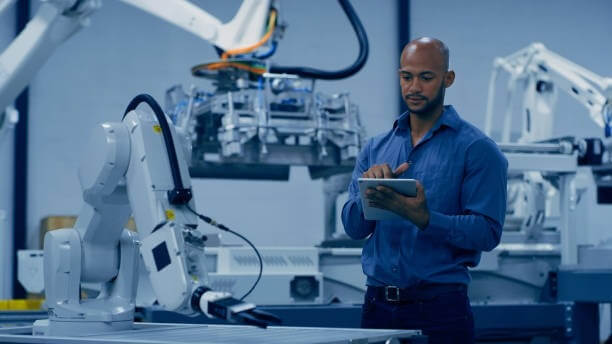Proximity sensors are very important in industrial automation as they are used for non-contact object detection, which enhances productivity and safety in automated systems. Capacitive and inductive proximity sensors are two of the most utilized types of proximity sensors and, as with all other types, both serve the purpose of object identification but differ in the techniques used and their respective applications. The importance of knowing the distinctions between these two sensor types like proverbial black and white is not lost when selecting the optimal one. Industrial Automation Inc, for example, has an extensive list of options for you to choose from in proximity sensors, and this guides which sensor to select for your automation needs.
What is a Capacitive Sensor Proximity?
A capacitive proximity sensor detects changes in force fields. Whenever an object or individual enters the field of the sensor, the electric field changes position. The proximity sensor first emits force fields, and if some object –whether that item is metallic or not –comes within the field of the sensor, there is a modification in the capacitance of the sensor. This leads to an output cue. A. Unlike inductive sensors, capacitive sensors can detect all types of objects such as liquids, pills, plastics and wood as well and works further with versatility. Hence, it is very efficient in enduring different specimen detections. Sensors of this type are extensively used in a variety of industries, including food processing, pharmaceuticals, packaging, and material handling, because they help in the detection of non-metallic plastic objects, powders, liquids, and even granular materials. This intrinsic ability to penetrate thin coverings of solid non-metals when monitoring various materials give them an upper hand in industrial applications where agility in non-metallic sensing is obligatory. Inc. Industrial Automation supplies capacitive sensors for detecting materials of various shapes and differing sensitivity levels to various industrial needs. The lack of mechanical contact increases the effectiveness of the system and decreases the wear and tear of elements of PMT.
What is an Inductive Proximity Sensor?
An inductive proximity sensor includes a detector head from which a magnetic field is generated. This device senses the presence of a metallic object by the change in the magnetic field. An inductive sensor is built to identify the presence of a metal object. This sensor is incapable of detecting an object that is non-metal. One of the main features of inductive proximity sensors is the contactless, highly reliable and precise detection of metallic bodies at short to medium distances. In industrial automation, they are utilized for machine location, metal piece recognition, robotic arms, and other assembly line functions. They are the best option for finding parts in tough conditions like high temperatures, dust, and vibration. Manufacturers and automobile plants that constantly depend on precise recognition of metal objects appreciate the durability and longevity of inductive sensors. Inductive proximity sensors that are highly sensitive, respond quickly, and are tough enough to survive harsh settings are available from Industrial automation inc. They are helpful in the environments when precision metal detection without contact is needed, which cuts the chances of mistakes and wasted time.
Differences Between Capacitive and Inductive Proximity Sensors
A comparison of capacitive versus inductive proximity sensors starts with differentiating their fundamental functions. The primary difference is in the type of object each type of sensor is intended to detect: capacitive sensors can identify both metallic and non-metallic targets, while inductive sensors can only identify metallic targets. This difference is vital in deciding which sensor is more suitable for automation systems, as it can help narrow down the choice. Besides, small non-metallic objects are easier to sense by capacitive sensors than by inductive ones. On the other hand, using Inductive sensors as metal part detectors guarantees high speed precision and reliability in industrial applications. However, external conditions have a role to play, because these sensors are less affected by moisture, dust and vibration than the other types. Therefore they are more reliable in harsh conditions. Inductive sensors can, however, be relied on in highly versatile roles, as is the case in the food, and pharmaceutical industries that deal and require utmost hygiene.
Knowing how each setup executes capacitive and inductive proximity sensor features on a specific device will help you make an appropriate decision for your automation system.
Integrating Capacitive and Inductive Sensors into the Automation System
Automation systems should integrate capacitive proximity sensors to detect and sense motion of non-metallic objects or materials. They are versatile and can detect a wide range of objects, from liquids in tanks to plastic containers on conveyors. Plastic sensors are also tremendously helpful in cases where accurate measurement of the level, thickness, or fill level in the non-metallic vessels is needed in food and beverage, chemicals, and packaged goods. They can detect certain liquids and powders, plastic, and provide measurements even when the materials are encased in non-metallic containers. Moreover, capacitive sensors are excellent in detecting the presence of items made of glass or plastic when at least one barrier of non-metallic material exists. Where there is a predominance of metals having an environment that requires close range detection, inductive proximity sensors prove to be the solution. Allowance is made for assembly lines of metal parts, robotic arms, and other machining operations where close range induction metal detection is needed. These sensors operate effectively to recognize small metal parts, pieces, and units of machinery, as well as components that are made of metals.
Thermal sensors offer particular benefits for detecting different composition materials, whether you are working on non-metallic materials or metals.
Conclusion
Capacitive vs inductive proximity sensor selection varies greatly depending on your individual needs regarding application and the surrounding environment. With capacitive sensors, a varied range of materials including non-metal objects, liquids, and even plastics can be detected. Such attributes make the sensors very useful across a wide range of industries. However, for high precision and reliable detection of metal objects even in extreme environments, inductive sensors are unmatched. Industrial Automation Inc has a very wide selection of both, which makes it easier for Industries to find the best type of proximity sensors for their needs. Assuring optimal effectiveness of an automation system and boosting overall operational productivity is easier when the merits and uniqueness of each sensor type are well understood. The seamless and reliable automation of different environments is delivered when the right sensor is selected. Be it a capacitive proximity sensor for versatile material detection or an inductive proximity sensor for precise metal detection, the automation system works effortlessly. Increased productivity, accuracy, and operational safety are some of the benefits businesses can achieve with the right choices.






